
What did you notice here? Is it Christmas or Diwali celebration?
Maybe yes.
But it’s a conversion of chemical energy of crackers into heat energy and sound energy.
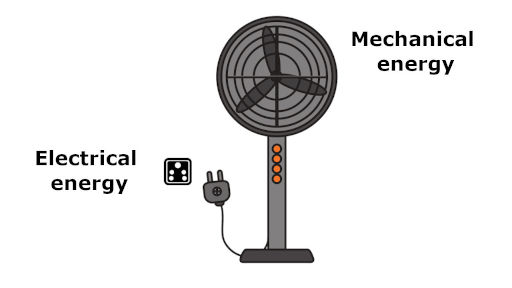
What happens here? The electrical energy is converted to mechanical energy of the fan.
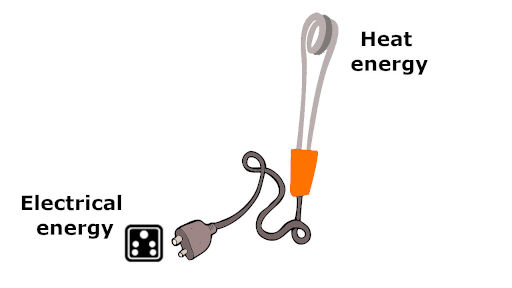
Here you can see that the electrical energy is converted to heat energy using the water heating coil.
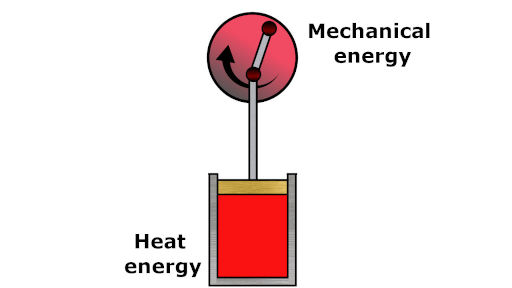
Here, the heat energy of fuel is converted to mechanical energy. This is how your car engine works.
Now, I’ll show you what is First law of thermodynamics.
First law of thermodynamics:
“Energy can neither be created nor can be destroyed but transformation of one form into another form can be possible.”
This means that the total amount of energy in the universe remains constant.
I’ll explain you this definition/statement of first law of thermodynamics with amazing examples (you will really love this)
I will also tell you why it is known as the law of conservation of energy.
You will get the exact idea about the equation of first law of thermodynamics, it’s examples, applications and limitations too.
I will also show some practical everyday life examples of the first law of thermodynamics which happens around you in nature.
If you want to skip to any part of this article, feel free to read your interested topic from the table given below.
Before moving further, if you want to know what is thermodynamics, you can refer previous article on basics of thermodynamics.
Contents
First law of thermodynamics or law of conservation of energy
It’s very simple;
“Energy can neither be created nor can be destroyed but transformation of one form into another form can be possible.”
Now let me explain this.
The energy can be of different form.
1). Heat energy

2). Mechanical energy

3). Chemical energy
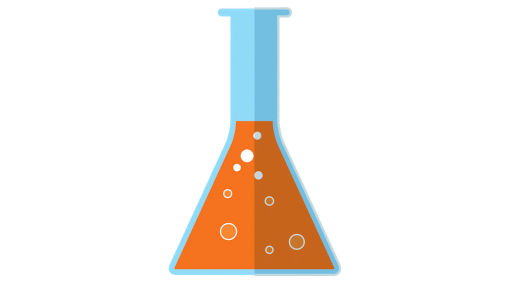
4). Electrical energy

All these energies can be converted from one form to another.
But how?
Just look at this.
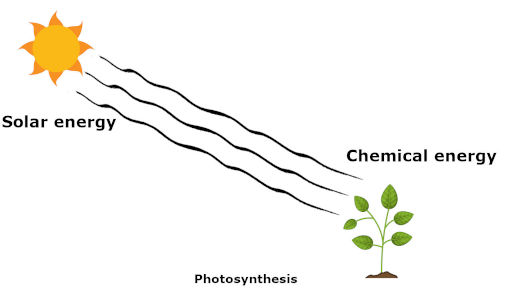
The heat energy of the sun is absorbed by the plants in the form of chemical energy through photosynthesis. Here, you can see the conversation of heat energy into chemical energy.
The energy is just transformed from one form to another.

In your home appliance like fan, mixer, grinder, etc, the electrical energy is converted into mechanical energy. Here also the energy is transformed from one form to another.

What type of energy conversion is taking place here…?
The electrical energy is used to heat the water inside this water heating coil. That means electrical energy is converted into heat energy.

Here also the conservation of energy takes place.
Look, the rocket contains some chemicals which have chemical energy.
When this rocket is ignited, it moves up in the sky and it bursts in the sky.
What exactly happened here?
It’s simple, the chemical energy of the rocket gets converted into heat energy and sound energy in the sky.
This is how the 1st law of thermodynamics or law of conservation of energy appears here in this example.
Isn’t it a cool example? (Let me know in the comments below)
Let me tell you something interesting now.
There are two more classification of energy.
- Kinetic energy
- Potential energy
Kinetic energy: Kinetic energy is the energy which an object possesses due to its motion.

For example, if any object is moving with some velocity, then it possesses kinetic energy.
Potential energy: Potential energy is the energy stored in a body due to its position with respect to some other body.

For example, this stone is at some height with respect to ground. So, it contains potential energy in it.
Now, let me explain to you how this kinetic energy and potential energy are converted from one form to another.

This boy is holding the stone in his hand. Just think which type of energy this stone is having right now?
It’s potential energy. Right? Because the stone is at some height.
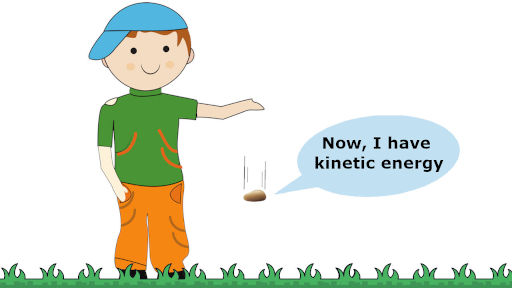
Now what happens when this boy releases this stone?
This stone will move down to the ground.
What type of energy is this?
It’s kinetic energy. Right? Because the stone is in motion now.
In this way, the potential energy of stone is converted into kinetic energy.
Here also the energy is transformed from one form to another. This kinetic energy is not created, but this is just a transformation from the potential energy to kinetic energy.
Thus, the energy remains conserved.
Hey, did you understand what exactly the conservation means?
Conservation means that the total value of the energy remains constant. It is neither increased nor decreased.
In the above example, we saw that the potential energy of stone is converted into kinetic energy.
Let’s say the potential energy of stone is 100 Joules.
Then the value of kinetic energy will also be 100 Joules.
That is what conservation of energy means.
Thus for the above practical example, we can write;
According to the law of conservation of energy,
Potential energy = Kinetic energy
For more examples, kindly visit this article: Examples of First Law of Thermodynamics
So many energies in a single picture (short and sweet)
Well, I’ll show you so many energies converting from one form to another in a single picture.

I hope you have understood every single conservation of energy from the image itself.
Now let’s see the equation of the first law of thermodynamics.
Equation for first law of thermodynamics
When I was a student, I had also faced few problems understanding the mathematical form of First law of Thermodynamics.
Then I read from different sources (books, internet, etc) and finally I have found the best way to remember the first law of thermodynamics equation, that also with proper understanding and practical examples.
Infact, the example which I have mentioned in this post makes me remember the 1st law of Thermodynamics very easily.
I will explain to you the entire equation for the first law of thermodynamics with a simple and beautiful real life example. (Trust me, you will love this)
In the previous section, we saw that the first law of thermodynamics is in fact the law of conservation of energy.
We saw that law of conservation of energy is;
“Energy can neither be created nor can be destroyed but transformation of one form into another form can be possible.”
But in terms of heat, internal energy and work, the definition/statement of first law of thermodynamics can be stated as;
“First law of thermodynamics: The net change in total energy of a system (∆E) is equal to the heat added to the system (Q) minus work done by the system (W).”
I know this is little bit complicated to understand.
But don’t worry, I’ll explain you with an amazing example.

This boy takes the energy drink and he gains Q amount of energy from it. We can say that Q amount of energy is entering the body.
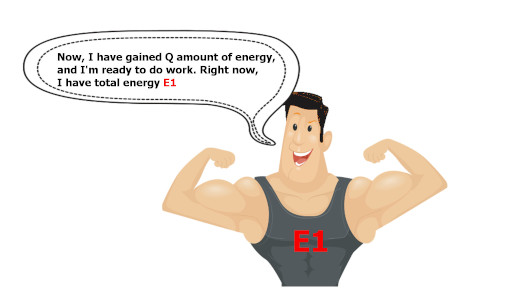
Now what have you noticed from the above Image? You can see that this body builder has gained Q amount of energy and he is ready to do work. And right now, he is having total energy E1.
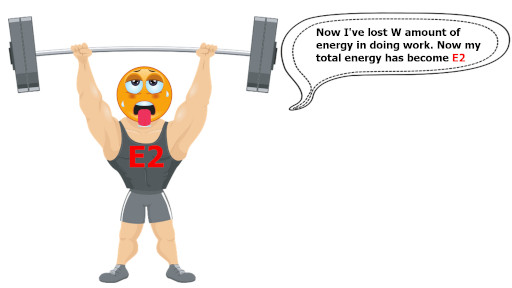
Now this muscular body spends some W amount of energy in doing work (here weight lifting), After doing this work, his total energy becomes E2.
Now, let me explain these things with some equations.
It’s easy. Don’t worry.
Now here,
Q = Inlet energy to the body
W = Outlet energy in the form of work
E1 = Total energy that boy is having during initial state
E2 = Total energy that boy is having during the final state
Here, the body gains Q amount of energy as shown in the above image. And after sometime the body is spending some W amount of energy in doing work.
Hence the net change in total energy of the body is given by Q – W.
I told you guys that the boys total energy was E1 and then it became E2. Thus, this change in total energy is nothing but E2 – E1.
Above statement can be mathematically written as;
E2 – E1 = Q – W
Therefore, ∆E = Q – W
This equation is known as the first law of thermodynamics.
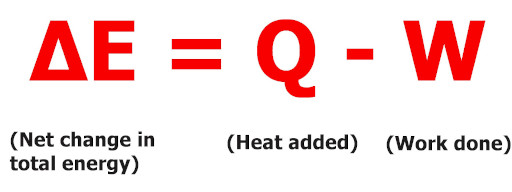
Now I guarantee you that you will understand this definition/statement of first law of thermodynamics very easily.
First law of thermodynamics: The net change in total energy of a system (∆E) is equal to the heat added to the system (Q) minus work done by the system (W).
Whenever heat(Q) is added to the system, the change in total energy of the system (∆E) increases. But whenever the work(W) is done by the system, then the change in total energy of the system decreases
(It’s simple. Just refer the equation ∆E = Q – W. Here, if Q increases, then ∆E also increases and if W increases, then ∆E decreases)
This total energy ∆E is nothing but a sum of kinetic energy, potential energy and other energies present in the molecules of the body, which is also known as internal energy ∆U.
I’ve explained all these things later in this article. Don’t worry.
Keep reading.
Also see,
1). Thermodynamic systems (with examples)
2). Thermodynamic process (with examples)
What is heat? How is it related to the 1st law of thermodynamics?
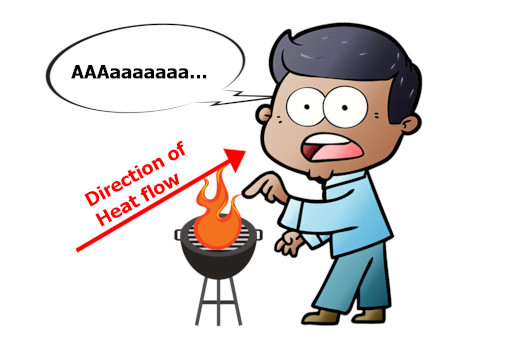
What can you see in this above image? The boy touches the hot flames by mistake and he feels it very hot.
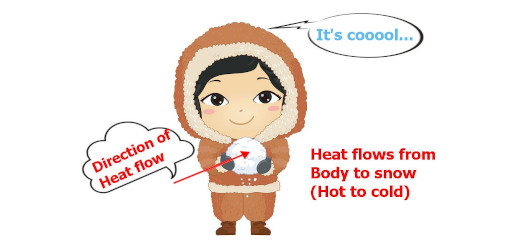
This cute boy is feeling cold as he is holding ice in his hand.
I want to ask you one question. Why do we feel cold or hot?
Let me explain to you how thermodynamics plays an important role here. And this will make you understand the concept of heat very easily.
When someone touches the hot flames, the thermal energy of the flame enters the body of that person, because the flame is hot as compared to the human body.
But think about the second case. When you touch the ice, the case is completely reversed. The thermal energy will pass out of your hand, because your hand is warmer than the ice.
What did you notice from these two examples of heat flow?
- Heat always flows from higher temperature to lower temperature.
- Heat flows due to temperature differences between the two objects.
Now let’s frame the definition from the above concepts.
Definition of heat: Heat is defined as a flow of thermal energy due to differences in temperatures.
Heat is simply thermal energy in transit.
Very easy, isn’t it?
Now, let me ask you a simple question.
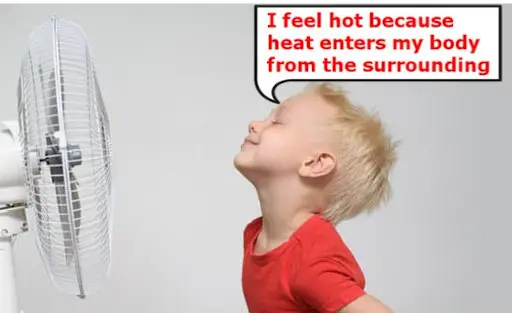
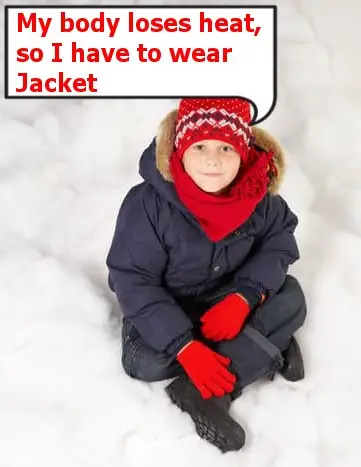
Why do we wear sweater during winter and not during summer?
I’ll explain the thermodynamics behind this.
Keep reading…
In Summer season, the heat enters the body from the surrounding. Thus we feel hot.
But what happens in winter? Why do we feel cold? What do you think, something like “Cold” enters our body?
No, it is not so.
Actually, in the winter season, our body loses heat to the surrounding (because in winter, our body is warmer than the surrounding. Remember, heat always flows from higher temperature to lower temperature)
This is the reason why we feel cold in the winter season.
And in order to avoid this heat loss from the body, we have to wear sweater in winter.
In other words, a sweater avoids the flow of heat from the body to the surrounding.
Now let’s discuss something regarding the unit of heat.
Heat is a type of energy, so it’s SI unit is the same as the unit of energy i.e Joule. It is denoted by “J”. In British Thermal Unit (BTU), the unit of heat is often used as “calorie”. It is denoted by “C”.
Remember that,
1 calorie = 4.18 Joules
Sign convention of heat in first law of thermodynamics
When the equation of 1st law of thermodynamics is used in calculations, it is necessary to know the sign of the heat(Q) and work(W).
Here I’ll show you the sign of heat (+ve or -ve).
When we should take Q as +ve and when we should take Q as -ve?
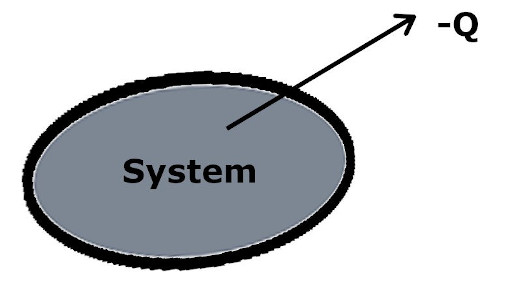
- When the heat is lost from the system, then we have to take Q as -ve. (Remember, if heat is going then minus sign)

- When the heat is supplied to the system, then we have to take Q as +ve. (Remember, if heat is coming then plus sign)
What is Internal energy in first law of thermodynamics?
This section is quite interesting.
Let’s take a simple example for understanding Internal energy.
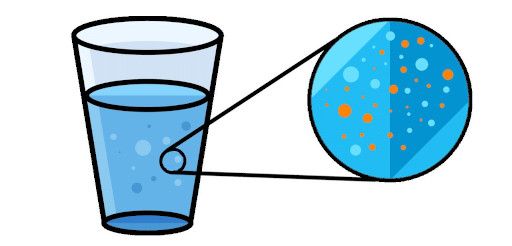
In this image you can see that the glass is filled with water.
What do you think about these water molecules as shown in the image? Do they remain steady or they perform any motion?
Well, the water molecules performs various types of motion like;
- Rotational motion
- Vibrational motion
- Translational motion
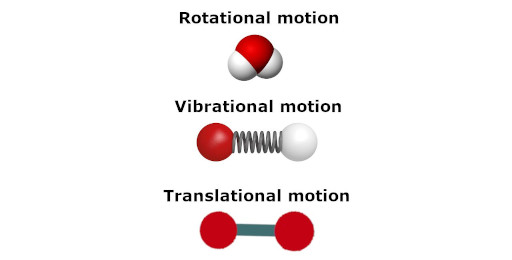
If we increase the temperature of water then these motions also increases and because of this, the kinetic energy of molecules also increases.
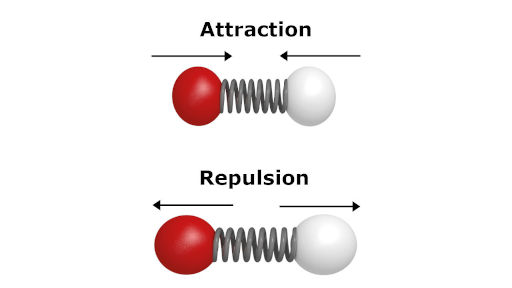
What do you understand by this above image?
You can see that the molecules are also bound with each other with a force of attraction and they also experience a repulsive force.
These attractive and repulsive forces indicates the potential energy.
In short, the molecules of all the objects possess kinetic energy and potential energy.
And as these energies are present among the molecules they are known as molecular kinetic energy and molecular potential energy.
Now, Internal energy is nothing but the sum of this molecular kinetic energy and molecular potential energy.

Now, internal energy is associated with the temperature of the object.
If the temperature is higher, then the internal energy is more.
If the temperature is lower, then the internal energy is less.
Remember: A system does not contain heat. But it contains internal energy.
What is work? How is it related to the 1st law of thermodynamics?
Do you know why I’m discussing this topic here?
Because it is very important for you to know about work for understanding the applications of the first law of thermodynamics.
Now let me ask you a simple question.
When can we say that work is done?
When a force is applied to any body and if that body moves in the direction of applied force, then we can say that work is done.
During the thermodynamic process, the volume of the system may increase or decrease.
But how will you decide that the thermodynamic system is doing work on the surrounding or surrounding is doing work on the system.
Who is doing work on whom?
In order to decide this, let’s consider a piston cylinder assembly as shown below.

You can see that when heat is supplied to the system, then its volume increases.
Let;
V1 = initial volume of the system
V2 = final volume of the system
P = constant pressure of the system
See, here the pressure of the system remains constant because, as heat is supplied, the volume increases and thus the pressure remains constant or maintained inside the system.
The work done by the system can be obtained from following formula;
W = P (V2 – V1)
= P ∆V
Sign convention of work in first law of thermodynamics
What should be the sign of this work done?
Should it be positive or negative?
Let’s discuss this now.
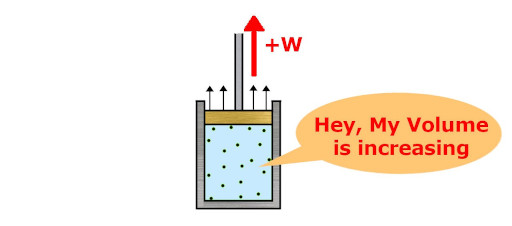
- When the volume of the system increases, then we have to take sign of work W as +ve. This is a work done by the system. (Remember: Volume increases then plus sign for work)

- When the volume of the system decreases, then we have to take sign of work W as -ve. This is a work done on the system. (Remember: Volume decreases then minus sign for work)
I hope you have clearly understood when you should take work positive or negative in thermodynamics.
Examples problems on first law of thermodynamics
Example 1: A system receives 224 Joule heat and does work of 156 joule. Calculate the change in the internal energy.
Solution:
System receives heat
So, Q = 224 joule
Work is done by the system
So, W = 156 joule
Now according to first law of thermodynamics;
∆U = Q – W
= 224 – 156
= 68 joules
Example 2: At one bar pressure, the volume of gas is 0.6 litre. If the gas receives 122 Joules of heat at one atmosphere pressure, the volume becomes 2 litres, then calculate it’s internal energy. (1 litre bar = 101.32 Joule).
Solution:
Pressure P = 1 bar
Initial volume of gas V1 = 0.6 litre
Final volume of gas V2 = 2 litre
∆V = V2 – V1
= 2 – 0.6
= 1.4 litre
Now, W = P ∆V
W = 1 × 1.4 = 1.4 litre bar
But 1 litre bar = 101.32 joule
So, W = 1.4 × 101.32
= 141.85 joule
Here, the work is done by the system
So, W = +141.85 joule
The heat obtained by the system
Q = 122 Joule
According to thermodynamics first law;
∆U = Q – W
= 122 – 141.85
= -19.85 joule
Perpetual motion machine of the first kind-PMM 1
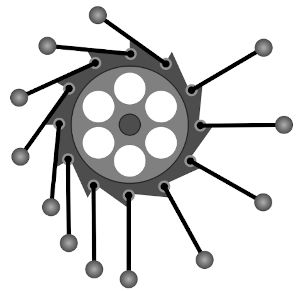
In 1st law of thermodynamics, we studied that;
“Energy can neither be created nor can be destroyed but transformation of one form into another form can be possible.”
Now,
The machine or a device which does not obey this first law of thermodynamics is known as a perpetual motion machine of first kind-PMM 1.
You can see in the picture, the device keeps on rotating on its own. It never stops.
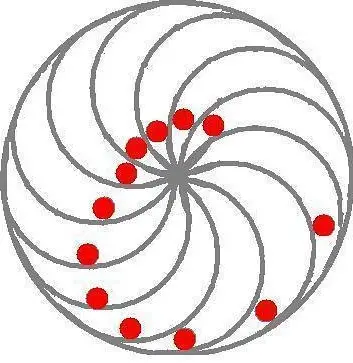
The motion of such devices or machines does not require any input energy, force or something like that.
Even though they keep on producing work.
But wait. How is this possible???
We have seen that energy can’t be created. It can just be transformed from one form to another.
If we are not giving any energy then why does this device keep on rotating?
This type of machine is impossible. This device does not obey the 1st law of thermodynamics.
This is the reason why such machines are known as perpetual motion machines.
(Note: perpetual motion machines are practically impossible)
Limitations of first law of thermodynamics
The limitations of the 1st law of thermodynamics are listed as under.
1). First law does not say anything about whether the process is possible or not.

For example, in engines, heat energy of fuel can be converted into useful mechanical work.
But we can not convert the mechanical work back into fuel. Such a reverse process is practically not possible.
First law of thermodynamics does not say anything about it.
2) First law of thermodynamics does not say whether the process will occur on its own or not.

Let me ask you a question. What will happen if you put ice on a table? It will melt down after some time on its own.
Now what about the reverse process (water to ice)?
Will this occur on its own?
The answer is NO.
We all know that conversion of water into ice does not occur on its own.
But, first law of thermodynamics does not say anything about this.
That means the first law of thermodynamics does not say whether the process occurs on its own or not. (In other words, the first law of thermodynamics does not tell us whether the process is spontaneous or not)
3). First law does not provide any sufficient condition for a certain process to take place.
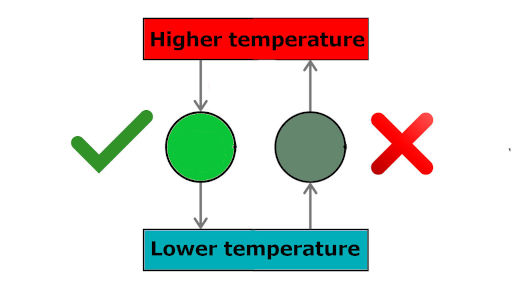
For example, we have already seen that heat always flows from higher temperature body to lower temperature body. But the reverse process is not possible. And this is automatic process. But what do you think, is reverse process possible on its own? Can we transfer heat from lower temperature body to higher temperature body without doing anything?
Do we need to supply anything to do this?
I don’t know. (Hahaha)
Even the 1st law of thermodynamics does not say anything about this.
In order to solve all these limitations of First law of thermodynamics, the second law of thermodynamics was discovered.
What is Heat capacity and Specific heat?
Heat capacity
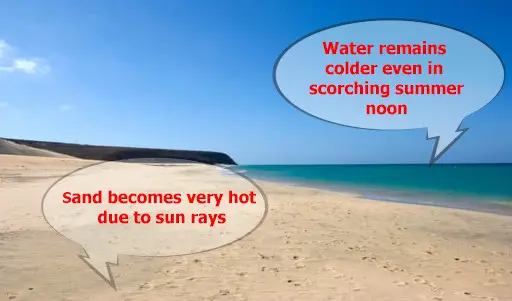
Just see the above picture. Sand is also receiving the same amount of heat (heat energy) from the sun and the water of the ocean is also receiving the same amount of heat from the sun.
Then why is there a difference in the temperature of sand and water?
What this happens?
Yay, the concept of heat capacity plays the impossible role here.
I’ll explain to you. Don’t worry.
As shown in the above picture, the sand gets heated more as compared to water.
We can say that, for heating the sand, only a few amount of heat is required. While for heating the water, a lot of heat is required.
In other words, sand is not having more capacity to absorb heat. While water keeps on absorbing the heat of the sun.
(Let me give you a funny example: A short tempered person gets angry very soon. While a calm person who keep on tolerating everything will not become angry soon)
Heat capacity is something similar to this.
The amount of heat required for the same change in temperature, is different for different objects.
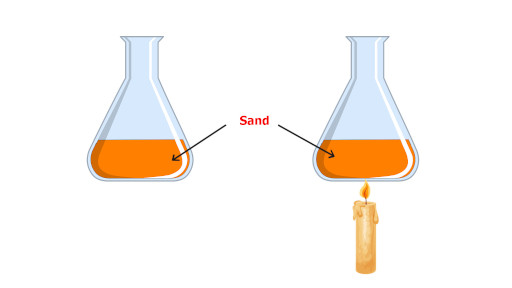
For example, take 1 kg of sand and right now it is at 20 °C. Now I want to increase its temperature to 25 °C. The amount of heat required to increase this temperature from 20 °C to 25 °C is say 1000 Joules.
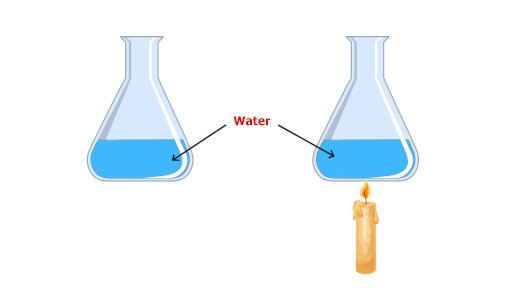
Now, take the same 1 kg of water in this bowl at 20 °C and increase its temperature to 25 °C using a burner.
Guess what will happen?
Will it consume more heat energy or less heat energy?
The answer is: Water will consume more heat energy compared to the same quantity of sand.
This happens because water has more capacity to absorb the heat.
Heat capacity (Hc): The ratio of heat supplied (Q) to the body to the change in it’s temperature ∆T is called heat capacity (Hc) of that body.
Hc = Q/∆T
Or
Heat capacity (Hc) is defined as the amount of heat absorbed (Q) in order to increase the temperature (∆T) by 1 unit.
How to remember this?
Just see this formula, Hc = Q/∆T.
In this formula, if ∆T is 1, then Q = Hc. Means heat absorbed or rejected (Q) is known as Heat capacity (Hc)]
The unit of heat capacity is J/K.
From the above example of sand and water, we noticed that heat capacity of sand is less, while heat capacity of water is more. That means heat capacity depends on the material of the body.
Also, one more thing I would like to add. Heat capacity also depends on the mass of the object. Bigger the mass of the object, the more heat will be absorbed, so it’s heat capacity will be more. While smaller the mass of the object, less heat will be absorbed, so it’s heat capacity will be less.
Specific heat capacity or specific heat (C)
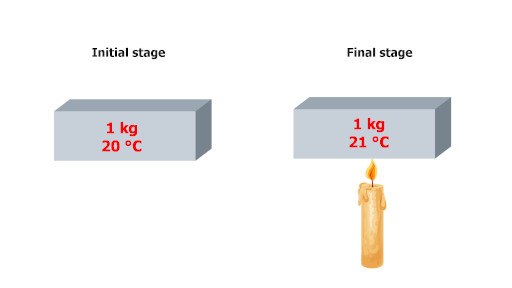
Everything is the same as heat capacity, we just have to take a unit mass over here.
I will explain.
Just see the above picture, you can see the iron block having 1 kg mass and during the initial stage its temperature is 20 °C.
Now, on applying some heat, its temperature rises by 1 °C and it’s temperature becomes 21 °C.
During this phenomenon, the amount of heat supplied is known as the specific heat capacity of the body.
Let me give you a clear definition.
Specific heat capacity (C): Specific heat capacity (C) is defined as the amount of heat absorbed (Q) in order to increase the temperature (∆T) by 1 unit, of a unit mass(m).
C = Q/m∆T
In other words, if the mass of a body is unity, then the heat capacity of the body is known as specific heat capacity or specific heat.
How to remember?
Just see this formula C = Q/m∆T.
In this formula, if ∆T = 1 and m = 1, then Q = C. Means heat absorbed (Q) is known as Specific heat capacity (C)]
The unit of specific heat capacity is J/kg K.
Remember: The specific heat capacity of water is 4182 J/kg K.
Also see: Heat capacity vs specific heat capacity (differences)
4 types of thermodynamic processes
Here I’ll explain the thermodynamic process in brief. Trust me you will enjoy this.
There are four types of thermodynamic processes.
Isobaric process
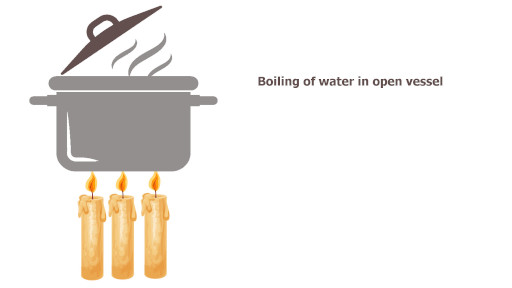
Have you seen this at your home?
I hope you have seen this. This is the boiling of water in an open vessel.
The boiling of water takes place at atmospheric pressure only. The pressure neither increases or decreases.
Such a thermodynamic process in which the pressure remains constant is called an isobaric process.
Isochoric process
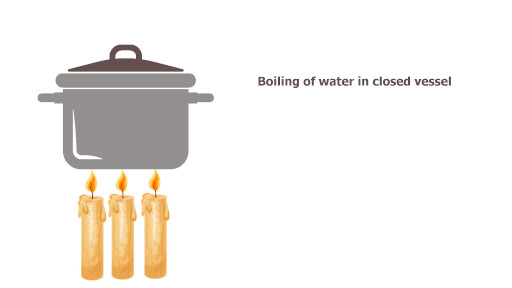
Hurray!!
Now I will close this vessel with the help of a lid and then I’ll boil the water.
Have you done this funny things in your life…(let me know in the comments below)
Hehehe…who boils water in a closed cooker.
Well, in this process the vessel/cooker is closed, meaning the volume of the vessel remains the same only. The volume is neither increasing nor decreasing.
Here the boiling of water takes place in some specified constant volume. Thus, the thermodynamic process in which the volume remains constant is called an isochoric process.
Adiabatic process
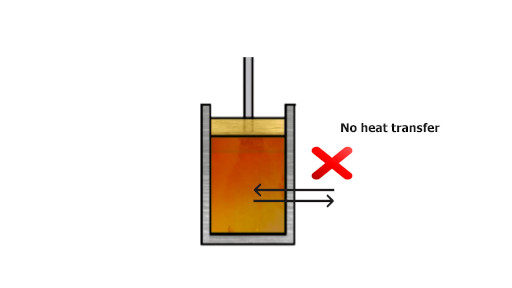
The thermodynamic process in which there is no heat transfer involved is called adiabatic process.
Let me give a simple example. Here is a piston and cylinder. The piston moves up and down, that means expansion and compression takes place over here. But there is no heat exchange occurring between this system and surrounding (∆Q = 0). Thus this is an example of adiabatic process.
Isothermal process
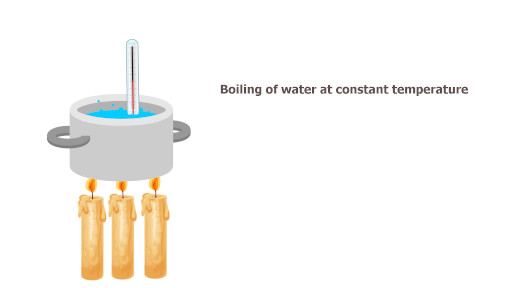
The thermodynamic process which occurs at constant temperature is known as isothermal process.
You have already observed the boiling of water at your home. But I’ll tell you what exactly happens during this process.
As shown in the above picture, the water is boiling, but this process occurs at the constant temperature. You can see the thermometer reading remains constant only.
Reversible and irreversible process
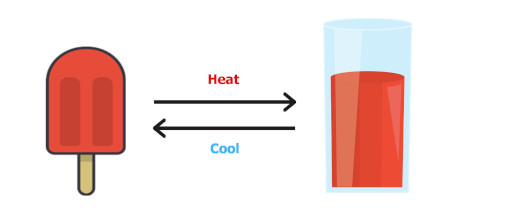
This ice cream can be converted to liquid on heating, and again it can be converted to ice cream on freezing.

Water can be converted to ice on freezing. And this ice can be again converted back to water on heating.
Reversible process: The thermodynamics process which can be reversed back to its original state is called reversible process.

This wood can be converted to fire, but fire can not be again converted to wood.
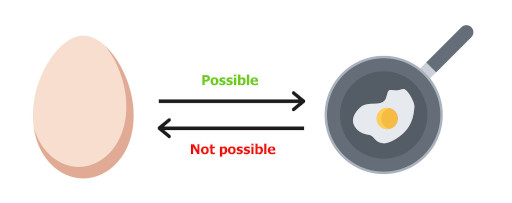
Egg can be fried on applying heat. But fried egg can not be converted to original egg on cooling it. (Do you eat eggs? Let me know in comments)
I hope you have got the idea of irreversible process.
Irreversible process: The thermodynamic process which can not be reversed back to it’s original state is called irreversible process.
Thermodynamics is really amazing and we can see it in our surroundings too. I hope you have clearly understood what is the first law of thermodynamics.
Summary (Read this if you are in hurry)
1st law of thermodynamics or law of conservation of energy
“Energy can neither be created nor can be destroyed but transformation of one form into another form can be possible.”
Equation that expresses first law of thermodynamics
The net change in total energy of a system (∆E) is equal to the heat added to the system (Q) minus work done by the system (W).
∆E = Q – W
What is heat? How is heat and first law of thermodynamics related to each other?
Definition of heat: Heat is defined as a flow of thermal energy due to differences in temperatures.
- Heat always flows from higher temperature to lower temperature.
- Heat flows due to temperature differences between the two objects.
- When the heat is lost from the system, then we have to take Q as -ve. (Remember, if heat is going then minus sign)
- When the heat is supplied to the system, then we have to take Q as +ve. (Remember, if heat is coming then plus sign)
Internal energy
Internal energy is nothing but the sum of this molecular kinetic energy and molecular potential energy.
How work is related to the 1st law of thermodynamics?
- When the volume of the system increases, then we have to take sign of work W as +ve. This is a work done by the system. (Remember: Volume increases then plus sign for work)
- When the volume of the system decreases, then we have to take sign of work W as -ve. This is a work done on the system. (Remember: Volume decreases then minus sign for work)
Perpetual motion machine of the first kind-PMM 1
The machine or a device which does not obey this first law of thermodynamics is known as a perpetual motion machine of first kind-PMM 1.
Limitations of first law of thermodynamics in points
1). First law does not say anything about whether the process is possible or not.
2).The process which occurs on its own can proceed in a particular direction only, but the first law does not give any information about the direction of this process.
3). First law does not provide any sufficient condition for a certain process to take place.
What is Heat capacity and Specific heat?
Heat capacity (Hc): The ratio of heat supplied (Q) to the body to the change in it’s temperature ∆T is called heat capacity (Hc) of that body.
Hc = Q/∆T
Or
Heat capacity (Hc) is defined as the amount of heat absorbed (Q) in order to increase the temperature (∆T) by 1 unit.
Specific heat capacity (C): Specific heat capacity (C) is defined as the amount of heat absorbed (Q) in order to increase the temperature (∆T) by 1 unit, of a unit mass(m).
C = Q/m∆T
In other words, if the mass of a body is unity, then the heat capacity of the body is known as specific heat capacity or specific heat.
4 types of thermodynamic processes
There are four types of thermodynamic processes.
1). Isobaric process: A thermodynamic process in which the pressure remains constant is called isobaric process.
2). Isochoric process: A thermodynamic process in which the volume remains constant is called isochoric process.
3). Adiabatic process: A thermodynamic process in which there is no heat transfer involved is called adiabatic process.
4). Isothermal process: A thermodynamic process which occurs at constant temperature is known as isothermal process.
Reversible and irreversible process
Reversible process: The thermodynamics process which can be reversed back to its original state is called reversible process.
Irreversible process: The thermodynamic process which can not be reversed back to its original state is called irreversible process.
Important Guides for you
Also read:
- What is Thermodynamics? (35+ topics with Definitions and basics)
- Zeroth law of thermodynamics
- What is second law of thermodynamics? [8+ Best examples to remember the law]
- Examples of Second Law of Thermodynamics (8+ best examples)
- Second Law of Thermodynamics Definition/Statement (Next level explanation)
- Second Law of Thermodynamics Equation [Practical explanation]
- What is Third law of thermodynamics? (in simple terms)
- Laws of thermodynamics
- What is Carnot Cycle in Thermodynamics?
- What is the definition of entropy in thermodynamics?
- Heat capacity vs specific heat in thermodynamics
- What is Thermodynamic Equilibrium? (With Best Example)
- Thermodynamic Process (With Examples)
- What is Thermodynamic System? – Open, Closed & Isolated system (With Examples)
